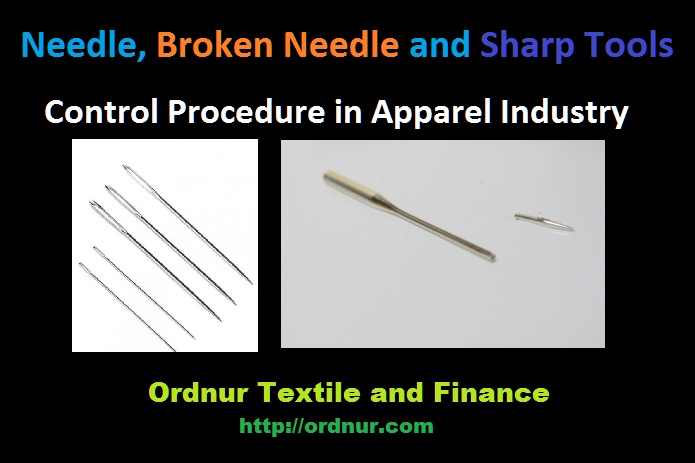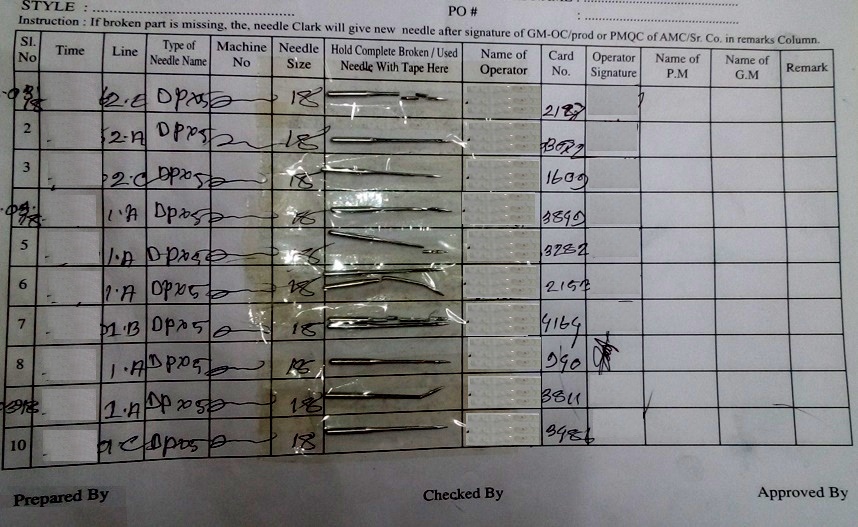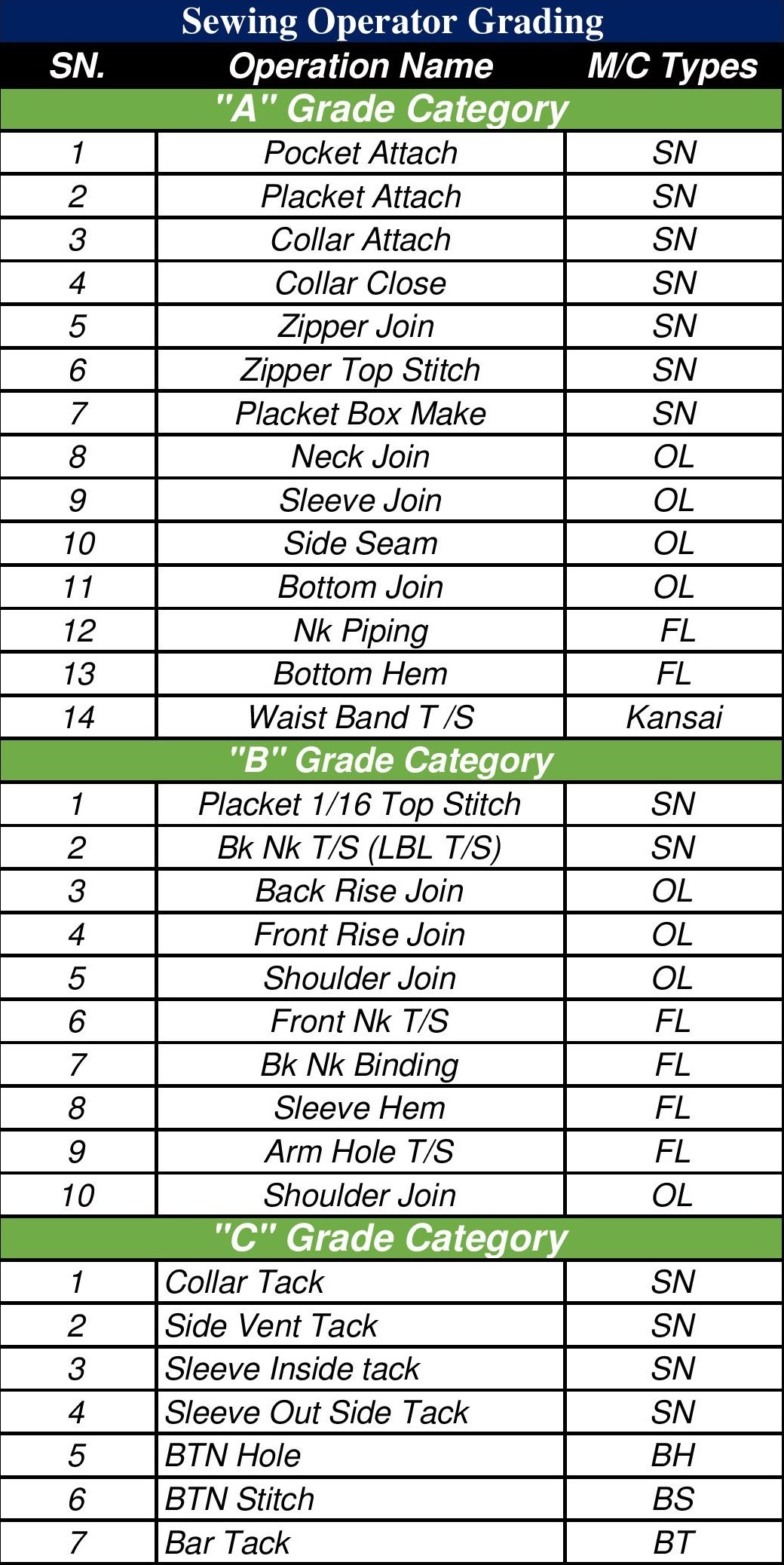Needle, Broken Needle, and Sharp Tools Control Procedure in Apparel Industry applies to all types of Machine needles, Hand Sewing needles, Label Applicator Gun needles, staples, and sharps (defined as knives, scissors, cutters, etc.). This article has two parts of controlling sharp items in the garments industry. One is a needle and broken needle control, the 2nd part is all other sharp tools control. All these items are sharp but they’re at least one needle in every sewing machine so we are giving needle control separately. Actually, every garment industry has to control the needle and other sharp tools separately. The needle used to sew garments. Scissor, cutter, and cutting knife used to cut fabrics and thread. And must eliminate staples from all areas, sections, raw materials (like supplier’s cartons), and processes of the factory. Loose sharp objects in any production-related area near fabric or garments are not allowed, they must be tied up. A general procedure for controlling all sharp tools are broken needle log/no needle on idle machines, no sharp points, no staples, and scissors attached & secured, blades control.
Needle and Sharp Tools Control Procedure in Apparel
List of Sharps Tools Used in Garments
- Sewing Needle
- Scissor
- Cutter (Thread trimmer)
- Cutting M/C Knife
- Cutting Clamps
- Loose Metal or M/C Parts
Needle Control
A needle issue booth is to be available on every production floor, only one person in the relevant department should be given the authority to operate the needle control procedure. The apparel industry has to set a needle control policy and manage the procedure effectively because safety is important for the Buyers & GMTS maker’s point of view. Applicable to sewing, embroidery, knitting & linking, or any other place where the needle is used or where there is a risk of metal contamination of the apparel manufacturing industry.
Objectives of Needle Control
- To ensure customer product safety
- To ensure safety for the employee
- To ensure safety for the consumer
- Keep discipline of sharp tools handling
- Safe working environment
Application of Needle Control Procedure
Machines not in production, should not have a needle attached. Mechanics must not leave spare needles with the machine after servicing. No spare or replaced needles should be held at the machine by an operator. The only needle allowed at the sewing machine is the one in use. All spare needles should keep in a secure location, keys for that location should be kept by the person who is responsible for managing the needle control procedure. When a needle breakage occurs, all broken parts must be found and taken to the person responsible for managing the needle and this ensures proper control procedure of needle. Once all the broken needle parts have been recovered, they must be attached with clear adhesive tape to a control sheet; a new needle may then be issued by the authorized distributor. If all the broken needle parts cannot be located, the work in the immediate area of the machine must be isolated and kept in a locked box. A metal detector should then be used to locate the missing needle pieces. Once the location of the needle pieces has been determined, the needle should be removed.
The article does not have to be destroyed if the whole needle piece has been removed. Handheld detectors are very useful for tracing lost needles in sewing rooms very quickly. One in each factory location is suggested. If the pieces cannot be located by the metal detector then the whole isolated batch of work should be destroyed. Records of all control sheets must be maintained. This also should be maintained in a locked, secure location. All whole needles replaced due to wear and tear should be held in a sealed container away from the factory floor and disposed of in a way, which would avoid injury to any persons. Glass items, e.g. bottles or paperweights, in the production area should also be discouraged in case of glass splinters. The use of snap-off blade type knives should not be used for any production or packaging, shipping areas – i.e. disposable metal blades, craft knives, etc. should not be used. The whole needle must be sealed in containers prior to the issue.
Action Need to Follow to Control Needle
- The Needle Status could be marked as “B” for Broken and “W” for Worn/Twisted/Crooked/Bent needles
- When a needle breakage occurs, all broken parts must be found and taken to the person responsible for managing the needle control procedure.
- Once all the broken needle parts have been recovered, they must be attached with clear adhesive tape to a control sheet; a new needle may then be issued by the authorized distributor.
- If all the broken needle parts cannot be located, the work in the immediate area of the machine must be isolated and passed through Metal Detector.
- If the pieces cannot be located by the metal detector, production in that area should be stopped; and the whole batch of work should be destroyed.
How to Control All Sharp Tools Used in Apparel/Garments
- Keep section wise records of all sharp tools quantity
- Supply all necessary sharp tools start of the workday and take this back end of the workday.
- Make sure any single number of tools not lost
- Keep section wise stock management report
- Tie all Scissor and cutter with relevant machine/table in work running time
- Staples should not use anywhere, staples threat for safety.
- Any metal or machine spare part not allowed to keep in the workplace.




how can i see needle disposal procedure
I like this… but i need missing sharp tools investigation procedure.
what are procedure for DISPOSAL PROCEDURE?
HOW & WHERE FACTORY DISPOSE BROKEN NEEDLE?
good. but what is the best broken needle dispose procedure
What’s the method of Idle machine needle control when it returns from the line?
sir mujhe needle mispoint polisy ka pura manual chahiye.
thanks
lekhraj
I Need a Needle Controller & sharp tool Controller Job
currently there is no vacancy